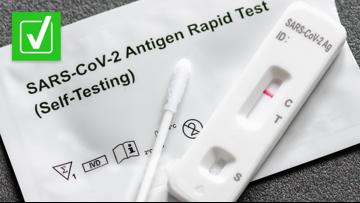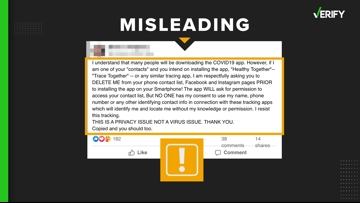UPDATE: Omicron subvariant BA.2 is now the dominant strain of COVID-19 in the U.S. Click here for our latest reporting. The original story continues as written below:
Multiple news reports are attributing a surge of COVID-19 cases in China to the omicron subvariant BA.2. It’s often informally referred to as “stealth" omicron because it has genetic mutations that could make it harder to identify through testing, the American Medical Association says.
Despite recent declines in COVID-19 case counts and the easing of mask guidance by the Centers for Disease Control and Prevention (CDC), some social media users are expressing concerns about another possible surge in the U.S. this year due to BA.2. The subvariant has become the “predominant lineage” of omicron in some countries, the World Health Organization (WHO) said on March 8.
A radiologist for the Department of Veterans Affairs said in a tweet on March 14 that the White House acknowledged BA.2 is “now circulating in the United States and has been for some time.”
THE QUESTION
Have BA.2, or “stealth” omicron, cases been reported in the United States?
THE SOURCES
- Jen Psaki, White House Press Secretary
- U.S. Centers for Disease Control and Prevention (CDC)
- Saralyn Mark, M.D., former senior medical advisor to the White House and American Medical Women's Association COVID-19 Lead
- Payal Kohli, M.D., assistant clinical professor of medicine at University of Colorado’s Anschutz Medical Campus
THE ANSWER
Yes, BA.2, or “stealth” omicron, cases have been reported in the United States.
WHAT WE FOUND
During a briefing on March 14, White House Press Secretary Jen Psaki acknowledged that BA.2 has “circulated in the United States for some time.”
“We currently have about 35,000 cases in this country. We expect some fluctuation, especially at this relatively low level, and, certainly, that to increase,” Psaki said.
From March 6 through March 12, BA.2 accounted for about 23% of COVID-19 cases in the U.S., according to estimates from the Centers for Disease Control and Prevention (CDC). That’s compared to about 66% of cases attributed to BA.1, the original version of omicron.
CDC data show BA.2 infections are rising in the United States. From Feb. 27 through March 5, an estimated 14% of cases in the U.S. were attributed to the subvariant, compared to about 72% of cases attributed to BA.1.
There could also be some cases of BA.2 in the U.S. that aren’t being reported since the subvariant is more difficult to detect, Payal Kohli, M.D., assistant clinical professor of medicine at the University of Colorado’s Anschutz Medical Campus, said.
Is BA.2 more contagious than the original version of omicron?
BA.2 may be more contagious than the original version of omicron, as it appears to have a “faster growth rate,” Kohli said. Medical experts believe BA.2 is about 1.5 times more transmissible than BA.1, Saralyn Mark, M.D., former senior medical advisor to the White House and American Medical Women's Association COVID-19 Lead, added.
Vaccines provide the same level of protection against severe illness and hospitalization of the BA.2 subvariant compared to other variants, according to Kohli, but it’s unclear right now if BA.2 makes people sicker.
“We have some preliminary data that appears to suggest that it may not necessarily increase, especially in vaccinated people, the number that are getting in the hospital, but we still need more information on that,” Kohli said. “And we are learning that some of our treatments are not working as well against the stealth variant.”
Will the U.S. see another surge in cases due to BA.2?
COVID-19 case rates in the U.S. could climb again, but Kohli doesn’t see BA.2 as an immediate concern since many people have immunity to the virus through natural infection or vaccination following the most recent omicron surge.
“My bigger concern for this variant is…come fall, come next winter,” Kohli said. “If it continues to be persistent and prevalent in our community, will we start to see more cases and surges occurring as a result of this?”
We could start to see COVID-19 case rates in the U.S. climb again in April or May of this year, Mark said.












